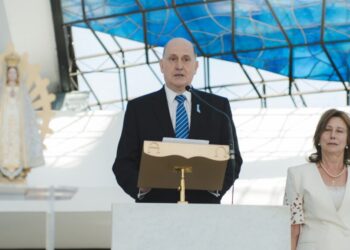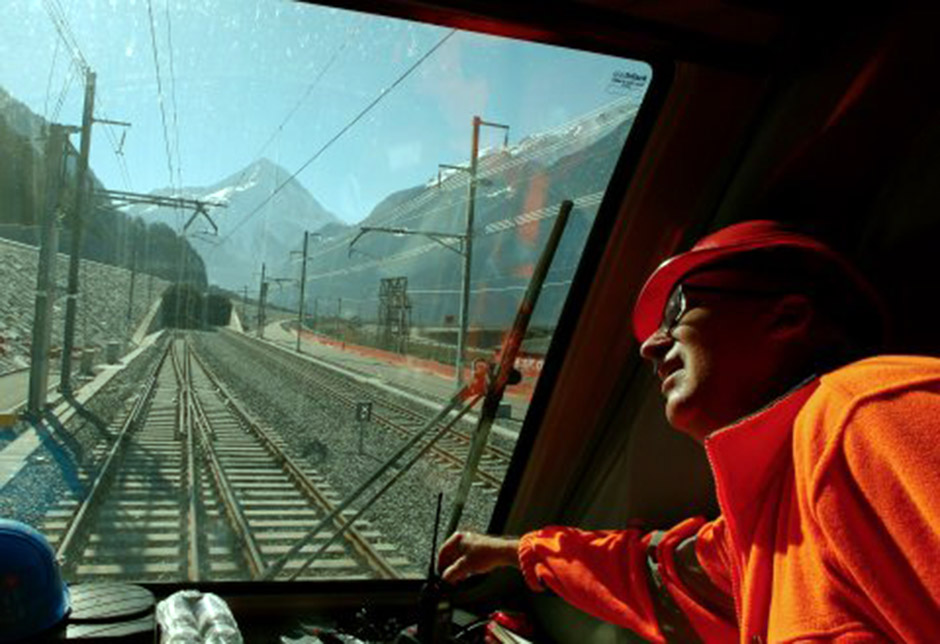[:pb]
The traditional caipira parties attract tourists and move five regions of the country. Anarriê!
|Oda Paula Fernandes
The party was originated in France and came to Brazil in the second half of the 19th century; it was brought by the imperial elites and went beyond the sophisticated salons invading the fields and becoming popular for Brazilian people. Back to the city, each region added a distinctive touch that differentiates each party from another and even folkloric references entered in the list that gave “new face” to the party throughout Brazil. The country is entitled to perform in Campina Grande (PB) the biggest junina party in the world. About two million tourists prestige the party annually.
Decorated with little colorful flags, the party has fires and quadrilles – dance presentation with colorful clothes representing the people of the interior of Brazil, swinging at the rhythm of the forró, accompanied by the sound of the triangle, the sanfona and zabumba –, it starts in June and goes to August to celebrate the Saints of June: Saint Antony (13), Saint John (24), Saint Peter and Saint Paul (29).
Anarriê derives from the French derrière and balancê is the Portuguese version of balancer. The tradition was influenced by modernity in its modern programming, but it still conserves the contagious atmosphere of the Brazilian rhythms, like the song Sonho de Papel (Paper Dream – in free translation), which is present in the repertoire of many junina parties throughout Brazil. “São João, São João, acende a fogueira do meu coração” (“Saint John, Saint John, light the fire of my heart” – in free translation), a verse from the popular song “Sonho de Papel”, composed by the carioca Alberto Ribeiro.
For the History specialist at the Universidade de Brasília (UnB), Jaime Almeida, the symbols of June are in all regions and make history mostly in the quadrilles. “It was a peasant dance, to which the elites gave a glaze of sophistication. In the course of time, the rhythm took the European salons and spread throughout the world. There is references about it even at the American Western movies”, he says.

Variations – In some states, other style of dances move the arraiá, as the northwestern swing, from the Northwest region; São João is celebrated in sites, parishes, camps and public spaces of the cities. Two of them are special. In Caruaru (PE) the party starts in June 4, dozens of allegorical cars floats through the streets. There is also ornamented carts, the courting the bacamarteiros (group that carries old gunfire), the acting of matuto weddings, fife band performances and folkloric groups.
The quadrilles are traditional all around Brazil, regardless of the characteristics of the region, except in São Paulo, where there is rodeos and parties of cowboys. In other states, the costumes for the celebration are traditional and imitate the typical caipira people, with a straw hat, plaid shirt and patched trousers. Women wear colorful and bulky patched dresses.

The North show is portrayed with the cattle creation tradition that was introduced by Portugal in Belém (PA), Parintins (AM) and Manaus (AM) resulting in the boi-bumbá, also known as ‘Bumba meu boi‘, danced in honor of the saints in June, but extending to other times of the year. The most famous groups compete for the championship title in Bumbódromo Parintins, between June 28 and 30.

In addition to these forms of Brazilian traditional parties, there are also the border of neighboring countries influence, such as Paraguay, which contributes to cultural elements in the June festivals in the region. The Paraguayan polka is a famous dance in the border cities. In Mato Grosso, the Araguaia Quadrille Festival happens for 15 years and the competition is one of the most expected; the costumes are very elaborate and the groups are specially synchronized. In the state of Goiás, country music and catira (typical dance of the interior of Brazil, especially in the area of influence of caipira culture – São Paulo, north of Paraná, Minas Gerais, Goiás and parts of Mato Grosso and Mato Grosso do Sul) rocks the participants.
Economy and Tourism – In the agreste of Paraíba, away from the sea and near the mountains, it happens the biggest junina party in the world, in Campina Grande. For 30 days (from June 3 to July 3) the city of 400 000 inhabitants becomes the stage of the greater São João on the planet. Quadrille, fire, typical foods, musical bands, culture and cuisine attract every year about 2 million tourists that invade the city in the search for the authentic caipira party.
According to the municipal government, that is the organizer of the event, in 2015 the investment to the celebrations was about 6 million reais. The hotels had occupancy of 90% and the expectation is that this year, despite of the economic crisis, this percentage reaches the 100% mark before the celebration.
The coordinator of Placement of Products of the Ministry of Tourism (MTur), Fabiana Oliveira, said that the idea is to make São João a national tourism product to enhance the national culture and stir the low season in June and July. The goal is to stimulate Brazilian tourism and to attract foreigners. “We want to expand the image of Brazil beyond the carnival and reduce the seasonality of tourism. The São João is stronger in the Northeast, perhaps because of the backwoods. The party has a religious characteristic, but it also refers to the harvest”, says Oliveira.
Enjoying it – What to visit
The sertão (Brazilian backwoods) offers more than São João. There are tours on the region and the city sights attract the attention of visitors.
Artisan Village – It is an oasis for local craft lovers. 260 craftsmen and 83 shops; the area has the infrastructure to serve the product selling, training courses, social movements, food court and parking.
Children Park – The space is 6,700 square meters, with relaxation area, a food court, field, football field, sports courts and lanes for bike rides; it is the largest in the city and it is next to the Açude Velho.
Jackson the Tambourine and Gonzagão – Bronze life-sized statue of the two mythical northeastern musicians.
Borborema Pioneers – Monument with three representative figures of culture and economy of Campina Grande. The Indian illustrates the primitive origin of the city with its fighting force. The drover personifies strength and trade. The cotton picker symbolizes the strength of women and the sharp industrial development of the city.
Junho: aberta temporada de arraiá no Brasil
Tradicionais festas caipiras atraem turistas e movimentam cinco regiões do país. Anarriê!
| Oda Paula Fernandes
A festa que veio da França ainda na segunda metade do século 19, trazida pelas elites imperiais, foi além dos salões sofisticados, invadiu a roça e caiu no gosto popular dos brasileiros. De volta à cidade, cada região adicionou um toque característico que diferencia uma festa da outra e até referências folclóricas deram “nova cara” à festa pelo Brasil. O país realiza, em Campina Grande (PB), a maior festa junina do mundo. Cerca de dois milhões de turistas prestigiam a festa anualmente.
A festa é decorada com bandeirolas coloridas e tem também fogueiras e quadrilhas – apresentação de dança com roupas esvoaçantes e coloridas embaladas pelo ritmo do forró, acompanhado pelo som do triângulo, da sanfona e da zabumba. As festas começam em junho e vão até o mês de agosto para comemorar os dias dos santos juninos – Santo Antônio (13), São João (24), São Pedro e São Paulo (29).
“Anarriê” deriva do Francês derrière, e o “balancê” deriva da versão aportuguesada do balancer. A tradição teve a influência da modernidade em suas programações modernas, mas mantém o clima contagiante dos ritmos brasileiros, como a música Sonho de Papel, que consta do repertório de várias festas juninas Brasil afora. “São João, são João, acende a fogueira do meu coração”, versinho da marcha ‘Sonho de papel’, do compositor carioca Alberto Ribeiro.
Para o especialista em história da Universidade de Brasília (UnB), Jaime de Almeida, os símbolos juninos estão em todas as regiões e fazem história, principalmente nas quadrilhas. “Era uma dança camponesa, a que as elites deram um verniz de sofisticação. Com o passar do tempo, o ritmo tomou os salões da Europa e se espalhou pelo mundo. Há referências até no faroeste americano”, diz.
As encenações do casamento matuto com personagens (noivos, pai da noiva, padre, sacristão, juiz e delegado) é outra adaptação brasileira. A história relata, de modo bem-humorado, na quadrilha, a tentativa de fuga do noivo diante de um casamento forçado. Nesta ocasião, além do entusiasmo, os participantes do teatro dançante carregam no sotaque ‘caipirês’.
Variações – Em alguns estados, outras danças movimentam o arraial, como é o caso do embalo nordestino, na Região Nordeste. O São João é celebrado em sítios, paróquias, nos arraiais e nos espaços públicos das cidades. Duas delas se destacam. Em Caruaru (PE), a festa começa em 4 de junho. Dezenas de carros alegóricos desfilam pelas ruas. Também há carroças ornamentadas, cortejo de bacamarteiros (grupo que carrega armas de fogo antigas), encenações de casamentos matutos, performances de bandas de pífano e de grupos folclóricos.
Em todo o Brasil, mesmo com suas características regionais, as quadrilhas são tradicionais, exceto no estado de São Paulo, onde há rodeios e festas de peão boiadeiro. Em outros estados, os trajes da comemoração são tradicionais e imitam o caipira típico, com chapéu de palha, camisa xadrez e calça remendada. As mulheres usam vestidos coloridos e volumosos também remendados.
A tradição sulista traz as festas do Sul que proporcionam um tour pela cultura regional. Alguns participantes usam trajes caipiras, outros investem em roupas tipicamente gaúchas. Os homens usam trajes de peão; as mulheres, roupas de prenda (vestidos volumosos bem elaborados). Em Santa Catarina e no Paraná, há apresentações de quadrilhas com o tradicional casamento na roça e grandes fogueiras. Há também a dança das fitas, ao redor de um mastro, que faz sucesso na região.
O espetáculo do Norte retrata a criação de bovinos introduzida por Portugal nas cidades de Belém (PA), Parintins (AM) e Manaus (AM), que resultou no boi-bumbá, também conhecido como ‘bumba meu boi’, dançado em homenagem aos santos em junho, mas que se estende a outras datas do ano. Os grupos mais famosos disputam o título de campeão no Bumbódromo de Parintins, entre 28 e 30 de junho.
A história encenada durante as apresentações no Norte do país é sobre um boi de estimação que perde a língua por desejo de uma mulher grávida, mas precisa voltar à vida para agradar ao seu dono. Um pajé faz o animal voltar a viver, para a alegria do elenco. Todos cantam e dançam ao redor de um boi cenográfico, ornamentado com flores e fitas coloridas, e conduzido pelo “tripa”, homem que dança embaixo do animal.
Além dessas formas de festas juninas brasileiras, há também influências da fronteira de nossos países vizinhos, como o Paraguai, que contribuem com elementos culturais nas festas juninas da região. A polca paraguaia é uma dança famosa em cidades da fronteira. Em Mato Grosso, o Festival de Quadrilha do Araguaia acontece há 15 anos. A competição é uma das mais esperadas. Os trajes são bem elaborados e os grupos capricham na sincronia. No estado de Goiás, a música sertaneja e a catira (dança típica do interior do Brasil, principalmente na área de influência da cultura caipira – São Paulo, norte do Paraná, Minas Gerais, Goiás e partes do Mato Grosso e Mato Grosso do Sul) embalam os participantes.
Economia e Turismo – No agreste paraibano, longe do mar e perto das serras, acontece o maior festejo junino do mundo, em Campina Grande. Por 30 dias (de 3 de junho a 3 de julho) a cidade de 400 mil habitantes se torna palco do maior São João do planeta. Quadrilha, fogueira, comidas típicas, bandas musicais, passeios pela cultura e culinária atraem todo ano aproximadamente 2 milhões de turistas que invadem a cidade em busca da autêntica festa caipira.
Segundo dados da prefeitura municipal, organizadora do evento, em 2015 o investimento foi de 6 milhões de reais para as comemorações. A rede hoteleira teve ocupação de 90% e a expectativa é que neste ano, mesmo com a crise econômica, esse percentual atinja a marca de 100% antes do início do festejo.
A coordenadora de Posicionamento de Produtos do Ministério do Turismo (MTur), Fabiana Oliveira, adianta que a ideia é fazer do São João um produto turístico nacional para valorizar a cultura nacional e agitar a baixa temporada no agreste nos meses de junho e julho. A meta é estimular o turismo brasileiro e atrair estrangeiros. “Queremos expandir a imagem do Brasil para além do carnaval e reduzir a sazonalidade do turismo. O São João é mais forte no Nordeste, talvez por causa do sertão. A festa tem caráter religioso, mas também faz referência à colheita”, conta Oliveira.
Alegria – O que conhecer
O sertão oferece mais que o São João. Há passeios pela região e na cidade pontos turísticos atraem a atenção dos visitantes.
Vila do artesão – É um oásis para os amantes de artesanato local. Com 260 artesãos e 83 lojas, o espaço conta com infraestrutura que serve para a comercialização dos produtos, cursos profissionalizantes, movimentos sociais, praça de alimentação e estacionamento.
Parque da Criança – 6.700 metros quadrados, com área de relaxamento, praça de alimentação, gramado, campo de futebol, quadras esportivas e pistas para passeios de bicicleta; é o maior da cidade e fica ao lado do Açude Velho.
Jackson do Pandeiro e Gonzagão – Estátua de bronze em tamanho real dos dois músicos nordestinos mais míticos.
Pioneiros de Borborema – Monumento com três figuras representativas da cultura e economia campinense. O índio sinaliza origem primitiva da cidade com sua força de luta. O tropeiro personifica a resistência e o comércio. A catadora de algodão simboliza a força da mulher e o acentuado desenvolvimento industrial da cidade.
[:]






